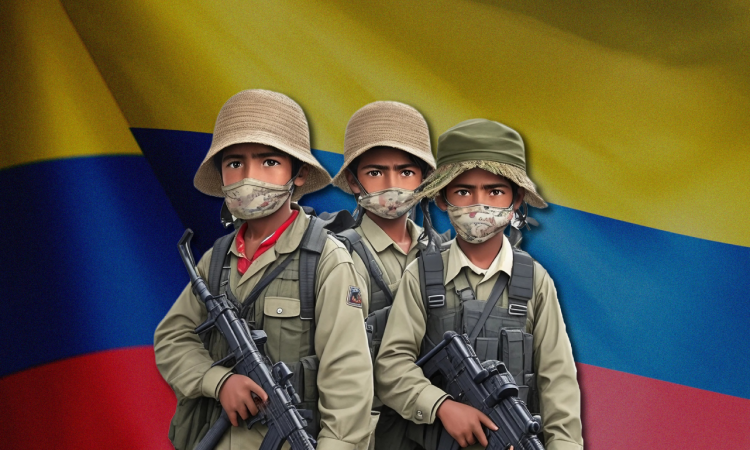Key Findings:
- Colombian President Gustavo Petro announced a new ceasefire agreement with criminal groups in December 2022. However, the national ombudsman says identified child recruitment has increased by 53 percent between Q1 2023 and Q1 2022.
- The provinces with the highest levels of identified minor recruitment since 2013 have been Antioquia, Chocó, Cauca, Nariño, and Caquetá.
- Guerrillas see in children and adolescents a disposable workforce. They can conduct errands, spy and provide information, manage explosives, murder, and guard drug labs. They can also be mules, soldiers, drivers, and weapons suppliers. Young females are subject to sexual violence and abuse.
- Not every child or adolescent joins armed groups by force. Some minors go voluntarily, due to remuneration in cash and/or room and board.
Context
On December 31, 2022, Colombian President Gustavo Petro—who was a member of the M19 guerrillas in the 1980s—announced a ceasefire agreement with five national criminal organizations. These were the:
- National Liberation Army (ELN);
- Central General Staff (EMC);
- Second Marquetalia;
- Gulf Clan;
- Self-Defense Forces of the Sierra Nevada.
Both EMC and Second Marquetalia are Revolutionary Armed Forces of Colombia (FARC) dissidents. The ceasefire was Petro’s first step in his plan towards achieving “total peace” in the country—which includes restarting peace negotiations with guerrillas.
The multilateral ceasefire agreement, expected to last until June 2023, ended early for the ELN, Gulf Clan, and EMC. On May 22, for example, EMC murdered four indigenous children in the Putumayo province, near the Ecuadorian border. The ceasefire agreement is still in place for the Second Marquetalia and the Self-Defense Forces of the Sierra Nevada.
According to a March 2023 statement by the Colombian Foundation for Peace and Reconciliation, the four largest criminal groups in Colombia are the ELN, with 5,882 members; the Gulf Clan, with 3,618 members; the EMC, with 3,480 members; and the Second Marquetalia, with 1,646 members.
Despite Petro’s stated desire to negotiate with criminal groups for his so-called total peace plan, these organizations have remained stubbornly active. In addition to expanding their territories—often claiming vacuums left by retired FARC cells—they are recruiting children and adolescents.
On April 28, Colombian Ombudsman Carlos Camargo revealed his office had identified 23 minors recruited by armed groups in the first quarter of 2023. That constitutes a 53 percent increase relative to the same period in 2022. In 2022, total known child recruitments for the year were 30 cases. However, the identified recruits in official numbers are the tip of the iceberg. No one has a precise gauge of how many minors are working with guerrillas and other criminal groups in Colombia.
Camargo fears the apparent increase in recruitment reflects a larger presence of criminal groups. Due to the scant data available on child recruitment, however, official figures represent a sliver of the problem. Further, considering that so little time has passed since Petro took office on August 7, 2022, there is little way to establish a clear relationship between his plan and the reported increase this year.
According to the Rome Statute of the International Criminal Court, “conscripting or enlisting children under the age of 15 years into the national armed forces or using them to participate actively in hostilities” is a war crime. Further, the Colombian Penal Code punishes with a 6–10 year prison sentence and an economic penalty of 600–1,000 times the monthly minimum wage ($242) for “illicit recruitment.” The term refers to armed forces recruiting minors.
This investigation examines the interactions between criminal organizations and minors in Colombia. The Impunity Observer interviewed: Mathew Charles, professor at the Colombian Observatory on Criminal Organizations, and Julia Castellanos, coordinator at the Colombian Observatory on Childhood and Armed Conflict.
The Most Affected Zones
The regions with the highest prevalence of child recruitment in 2023 are different from those of 2016, when the Colombian government signed a deal with the FARC guerrillas. Charles told the Impunity Observer that the affected zones vary depending on the interactions between armed groups and the government.
However, some FARC members giving up arms appears to have had limited effect. The economic opportunities related to crime remained, and other organizations expanded into those areas and recruited new members, including minors.
A 2023 study conducted by UNICEF and the state-led Colombian Institute for Family Well-Being revealed the provinces with the highest recruitment levels:
- Antioquia, 13.9 percent of the cases;
- Chocó, 13.3 percent;
- Cauca, 12.9 percent;
- Nariño, 10.8 percent;
- Caquetá, 8.5 percent.
Other regions that are common locations for child recruitment include Arauca, Meta, Putumayo, Bolívar, and North Santander.
Despite rural regions being the most affected by child recruitment, Castellanos and Charles agree this is a nationwide phenomenon that has been expanding since mid-2017. That was one year after the peace accord and what had been stable observed incidents.
Charles explains certain conflict dynamics lead to increases or decreases in child recruitment across Colombia. These include government strategies to tackle criminal groups—including military operations—and territorial fights between armed groups.
Armed groups recruit new members if they perceive they need a stronger presence to make a show of force—perhaps exaggerating their actual capacity—or battle law-enforcement agents and rivals. The former can be useful when negotiating deals with government officials.
Charles explains that Bajo Cauca and Vaupés had the highest levels of child recruitment between 2017 and 2019, due to an ongoing dispute between the Gulf Clan and the now defunct paramilitary group known as the Caparros. However, he says these areas are no longer the most affected due to more recent conflict dynamics.
Castellanos says North Santander and Putumayo are currently two of the Colombian provinces with the highest levels of child recruitment. This is mostly due to feuds between criminal groups and the central government’s withdrawal with Petro’s ceasefire agreement in these provinces.
Criminal Groups and Minors
A common way to recruit minors is to approach schools and houses when children and adolescents are either arriving or leaving. Members of criminal organizations convince, kidnap, or threaten them to join the group. They also visit the children’s homes and threaten the family members who lead their homes. These individuals face little choice but to let the children join the guerrillas or have themselves and their children killed.
One key reason for recruiting minors is the need for a disposable workforce or buffer to carry out tasks related to guerrilla interactions with government officials or other criminal groups. A less common reason is that armed groups might require some specific information or skill that a minor has or could get.
Castellanos and Charles agree that guerrillas find in minors energetic people with the potential to learn multiple activities and skills related to criminality. An additional benefit for criminal groups when recruiting minors, Charles contends, is that “the Colombian justice system usually has little to no sanctions when they get caught committing crimes.” Criminal organizations can also more easily teach Marxist ideology to children than to adults.
Minors often perform the same jobs as adults. These include errands, spying and providing information, managing explosives, murdering, guarding drug labs, drug and weapon transportation, and open combat. Female children are subject to sexual violence and abuse. For example, armed group leaders force females to be “their girlfriends,” explains Charles.
The activities that minors perform depend on how much their superiors trust them. The more trust there is the more important the activities that members can perform. Newcomers have to earn trust through different rituals such as dealing drugs, stealing weapons, passing loyalty tests, or even killing someone. When trust is lost, it usually results in the murder of the member.
Factors for Voluntarily Joining Guerrillas
Not all minors working for guerrillas join through recruitment. Recruitment implies leaving their home and moving to camps, but many minors do sporadic labor and do not abandon their places of residence. This is known as the utilization of minors. These dynamics vary throughout different criminal organizations and their needs.
Although popular belief is that armed groups force minors to join them, this is not always the case. On occasion, minors voluntarily join criminal groups, since they perceive that it will provide financial support for themselves and their families.
In Colombia, 39.5 percent of citizens are poor (earn less than US$2.15 per day), and 44.6 percent of this population lives in rural areas. Further, malnutrition is a problem of social concern, particularly in rural areas. For example, in 2022, at least 308 children under five years old died in Colombia from malnutrition.
According to a 2021 report authored by Charles, some youngsters join armed groups in exchange for remuneration, such as a salary or three meals per day. As documented by Charles, an armed group in Bajo Cauca offered a two-million Colombian peso bonus ($450) for joining them.
Having relatives that belong to a criminal organization and living in an area with the presence of multiple criminal organizations are also factors for joining a criminal organization. Similarly, living in an indigenous community and/or being a migrant are two common factors that make minors more vulnerable to voluntarily joining criminal groups.
Indigenous communities tend to have less law enforcement, so guerrillas roam more freely. That includes the Amazon region and along the borders with Ecuador, Peru, and Venezuela. Their locations make communities easy prey for criminal groups recruiting members.
Although accurate numbers are not forthcoming, Charles explains: “the perception is that there is a high number of Venezuelan children recruited.” Three factors that make Venezuelan children vulnerable to guerrillas are: (1) being alone, (2) living in slums, and (3) having low incomes. The national news outlet RCN estimated that by February 2022, three out of 10 members of Colombian armed groups were Venezuelan.
By crossing from Venezuela to Colombia through irregular passages, commonly known as trochas, Venezuelan minors also risk being recruited by guerrillas. As the Impunity Observer previously documented, guerrillas near the Colombia-Venezuela border control trochas. They manage to smuggle and charge migrants for passage across the border.
The recruitment of minors in Colombia appears to have become more common since the peace agreement between the government and FARC in 2016. This took place under President Juan Manuel Santos. Other criminal organizations swiftly filled power vacuums left by the FARC.
The perceived trends are driven more by anecdotes than by official counts, given such limited data. The precise number or rate of child recruitment is nigh impossible to calculate, but it does appear stubbornly persistent and now more common in urban areas.
On occasion—due to multiple factors such as poverty, family ties, and possible compensation—minors voluntarily join criminal groups. When joining criminal groups, the belief is they can improve their current situation and get economic benefits.
 Join us in our mission to foster positive relations between the United States and Latin America through independent journalism.
Join us in our mission to foster positive relations between the United States and Latin America through independent journalism.
As we improve our quality and deepen our coverage, we wish to make the Impunity Observer financially sustainable and reader-oriented. In return, we ask that you show your support in the form of subscriptions.
Non-subscribers can read up to six articles per month. Subscribe here.



